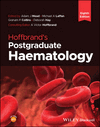Neonatal haematology
Irene Roberts
Department of Paediatrics and Weatherall Institute of Molecular Medicine, University of Oxford, Oxford, UK
Search for more papers by this authorSubarna Chakravorty
Department of Paediatric Haematology, King's College Hospital, London, UK
Search for more papers by this authorIrene Roberts
Department of Paediatrics and Weatherall Institute of Molecular Medicine, University of Oxford, Oxford, UK
Search for more papers by this authorSubarna Chakravorty
Department of Paediatric Haematology, King's College Hospital, London, UK
Search for more papers by this authorAdam J Mead PhD, FRCP, FRCPath, FMedSci
Haematopoietic Stem Cell Biology Laboratory, Medical Research Council Molecular Haematology Unit, Medical Research Council Weatherall Institute of Molecular Medicine, University of Oxford, Oxford, UK
Search for more papers by this authorMichael A Laffan DM, MRCP, FRCPath
Department of Immunology and Inflammation, Faculty of Medicine, Imperial College London, London, UK
Search for more papers by this authorGraham P Collins DPhil, FRCP, FRCPath
Department of Haematology, Oxford Cancer and Haematology Centre, Oxford, UK
Search for more papers by this authorDeborah Hay DPhil, MRCP, FRCPath
Nuffield Division of Clinical Laboratory Sciences, Radcliffe Department of Medicine, University of Oxford, Oxford, UK
Search for more papers by this authorA Victor Hoffbrand MA, DM, FRCP, FRCPath, FRCP (Edin), DSc, FMedSci
Emeritus Professor of Haematology Honorary Consultant Haematologist
University College London, London, UK
Royal Free Hospital, London, UK
Search for more papers by this authorSummary
The most common haematological problems in neonates are anaemia and thrombocytopenia. In the majority of cases, the causes are secondary, either as a result of pregnancy-related complications or prematurity. However, many rare inherited red cell, white cell, platelet and coagulation disorders present during the neonatal period when they often have characteristic clinical and haematological features distinct from those in adults. Diagnosis of haematological disorders in the neonate also requires a practical, logical approach that takes into account the developmental changes in most haematological parameters, knowledge of normal ranges, the importance of a careful family and pregnancy history and sample size limitations.
Selected bibliography
- Chakravorty S , Roberts I ( 2012 ) How I manage neonatal thrombocytopenia . British Journal of Haematology 156 : 155 – 62 .
- Chalmers E , Williams M , Brennand J et al .; on behalf of the Paediatric Working Party of the United Kingdom Haemophilia Doctors’ Organization ( 2011 ) Guideline on the management of haemophilia in the fetus and neonate . British Journal of Haematology 154 : 208 – 15 .
- Howarth C , Bannerjee J , Aladangady N ( 2018 ) Red blood cell transfusion in pre- term infants: current evidence and controversies . Neonatology 114 : 7 .
- Lieberman L , Greinacher A , Murphy MF et al . ( 2019 ) Fetal and neonatal alloimmune thrombocytopenia: recommendations for evidence-based practice, an international approach . British Journal of Haematology 185 : 549 – 62 .
- New HV , Berryman J , Bolton-Maggs PHB et al .; on behalf of the British Committee for Standards in Haematology ( 2016 ) Guidelines on trans- fusion for fetuses, neonates and older children . British Journal of Haematology 175 : 784
- Roy A , Roberts I , Vyas P ( 2012 ) Biology and management of transient abnormal myelopoiesis (TAM) in children with down syndrome . Seminars in Fetal and Neonatal Medicine 17 : 196 – 201 .
- Stanworth S , Mumford A ( 2023 ) How I diagnose and treat neonatal thrombocytopenia . Blood 141 ( 22 ): 2685 – 97 .
- Shearer MJ ( 2009 ) Vitamin K deficiency bleeding (VKDB) in early infancy . Blood Reviews 23 : 49 – 59 .
- Spruijt MS , Lopriore E , Steggerda S et al . ( 2020 ) Twin-to-twin transfusion syndrome in the era of fetoscopic laser surgery: antenatal management, neonatal outcome and beyond . Expert Review of Hematology 13 : 259 .
- Will A ( 2015 ) Neonatal haemostasis and the management of neonatal thrombosis . British Journal of Haematology 169 : 324 – 32 .
- Zwiers C , van Kamp I , Oepkes D et al . ( 2017 ) Intrauterine transfusion and non-invasive treatment options for hemolytic disease of the newborn – review on current management and outcomes . Expert Review of Hematology 10 : 337 .



